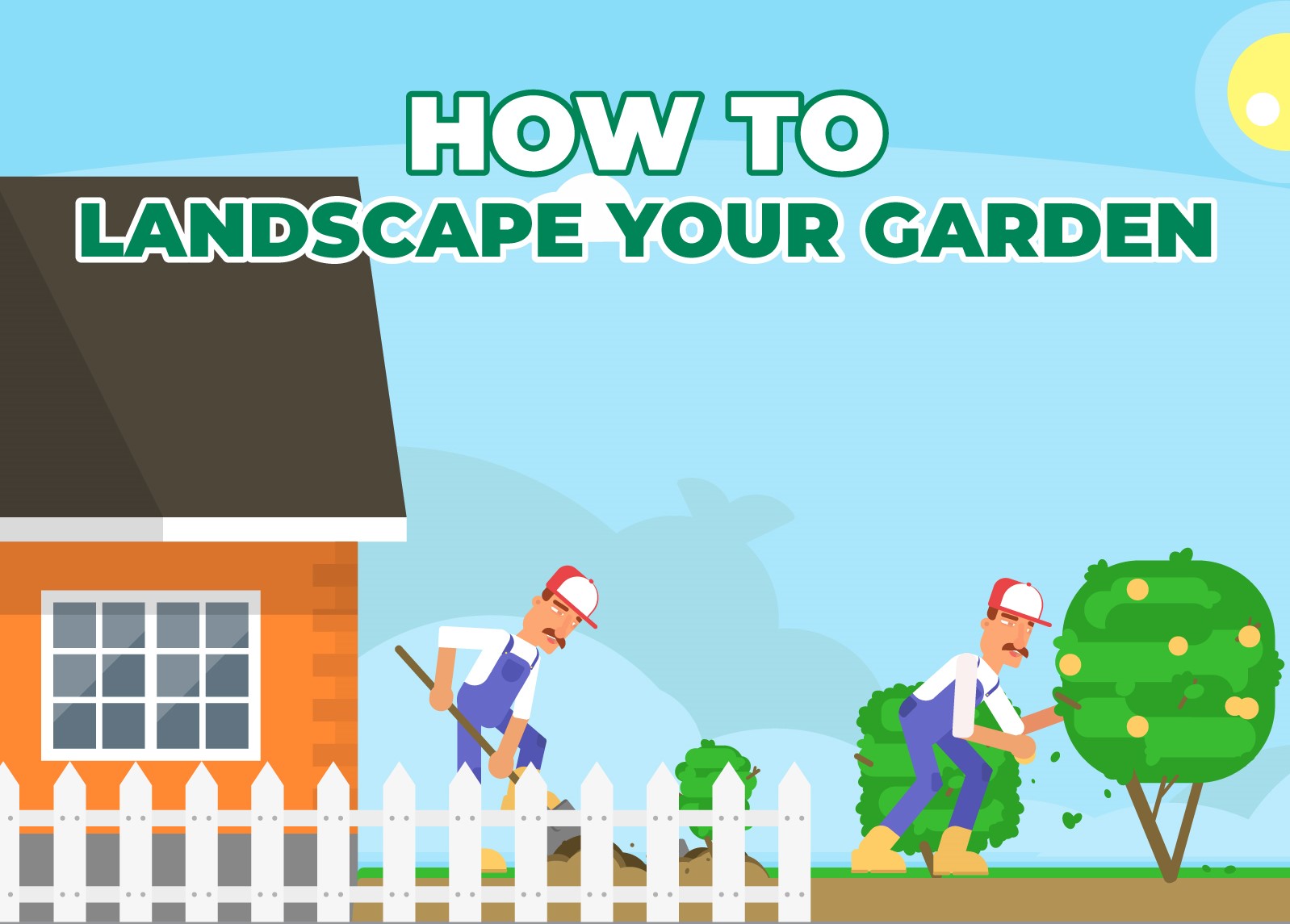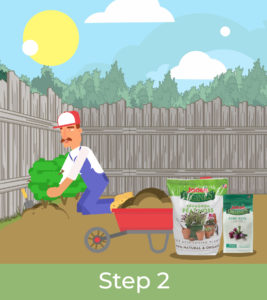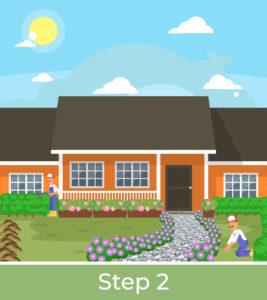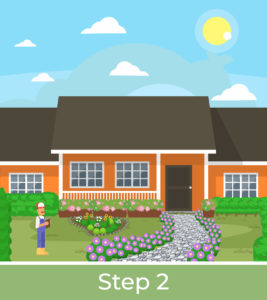Landscaping your yard is no little thing. No matter if you take a DIY approach or hire someone to do it for you, the process still requires planning on your part—as well as all the maintenance that follows. Jobe’s is here to offer some pointers and reminders for beginners and garden gurus alike before you get started.
Planning
Before you start digging in, don’t get ahead of yourself. Landscaping can add value and curb appeal to your home for years to come, so whether you’re planning to sell it down the road or make it your forever home, a yard makeover is best done right the first time.
Hardscape, Then Softscape
Start with the arguably least glamourous and creative part of the process: hardscaping. A hardscape refers to the structures more permanently built into the landscape, such as fencing, benches, retaining walls, porches, patios, and paved walkways and driveways. As opposed to the softscape—which includes the landscape’s horticultural elements—think of hardscape as the elements including materials like stone, wood, or concrete.
Materials You Might Need
If you’re opting to do it yourself, you’ll need to eventually round up all the tools, materials, and products so everything progresses smoothly once you begin. Ensuring you properly compact, install, and level off subgrade materials as the foundation of your landscaping is crucial to the project’s success.
Some items you might need for hardscaping include:
- Level
- Screed rails
- Shovels
- Trowel
- Rakes
- Excavators
- Mason’s hammer
- Mashing hammer
- Blocking chisel
- Power saw
- Angle grinder
- Plate compactor
- Landscape fabric
- Polymeric sand
- Materials for retaining walls (boulders, blocks, bricks, masonry, etc.)
For softscaping, your materials are pretty straightforward: plants. Think about how you’d like to use them to “soften” your landscape. Trees, shrubbery, and other shades of green will give your yard a more natural feel, while a mix of annual or perennial flowers can spice things up with bursts of color.
Some items you might need for softscaping include:
- Soil or potting mix
- Soil amendments
- Fertilizer
- Mulch
- Grass or ivy
- Decorative stones or rocks
- A truck or other vehicle to securely transport materials
Keep Design in Mind
When you’re first crafting your vision for your landscape, rough sketches can be handy for inspiration and keeping track of your thoughts, no matter if it’s for your own reference or a contractor’s. Consider the optimal locations for both hardscaping and softscaping elements by studying sun and wind patterns around your yard. For instance, installing a deck on the west side of your home would be pleasant for sunset-watching in the fall…but perhaps not for a summertime outdoor dinner.
Therefore, accurately gauging the sunniest, shadiest, and windiest spots in your yard requires you spending mindful time in it. Who knows—you might discover a sweet spot for a bench that you hadn’t considered before! Of course, you’ll also need to plan based on which plants require full sunlight, like such vegetables or roses, and which require some shade, like hostas and impatiens.
Deciding on all the plants you want to incorporate can bring the most excitement as well as the most indecision. Remember to establish a balance between repetitive elements and new elements. While you don’t necessarily want a design so consistent that it just blends in, you don’t want the colors and types of plants to look scattered or disjointed. It’s best, for example, for the tallest plants to stand in the back of a flowerbed, but if you strictly follow a rule of placing plants tallest to shortest from front to back, it might appear too formulaic.
When in doubt, research tips and inspiration for what you should plant next to each other. Choosing a few complementary colors for flowering plants is a good way to give yourself direction and eliminate the stress of endless options.
Planting
Especially if you’re doing it yourself, it’s wise to start small and break up your workload into manageable pieces that allow you to enjoy the process as much as possible. You can start with establishing a small flower bed and move forward steadily from there. Not only will this prevent the urge to take sloppy shortcuts, but it will also give you the satisfaction of watching your landscape become something grand from the ground up.
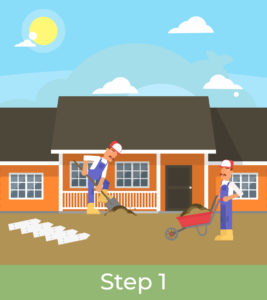
Set Up the Soil for Success
When it’s finally time to start gardening, amend the soil by adding organic matter such as compost, shredded pine bark, peat moss, or bone meal before setting seeds and plants.
Fertilized and loosened soil will encourage new plantings’ roots to establish. Before setting anything, define and mark the boundaries of your turf and beds so you don’t have to dig anything up later.
Create Focal Points
An eye-catching garden design will often include one or more focal points. Whether it’s a standout plant, series of shrubs, or garden sculpture, allow the design to draw the eye to both the focal point as well as what’s around it. Many people start their landscaping in the front yard, as that’s what is most visible and offers the most curb appeal. Placing shrubs along the edges of a walkway up to the house—or flowers that frame the front door—is a functional yet tasteful tactic.

Soften Around the Edges
Unless you happen to live in a very unique building, most houses have sharp edges with a box-like look. One of the greatest assets of a scenic landscape is its ability to ease the harsh edges of a home. Use trees and shrubs to your advantage by planting them around the sides or at the corners of your house.
Maintenance
So, you’ve dumped the last pile of mulch around those new shrubs and given your flowers a good drink, and you’re ready to enjoy the atmosphere of your hard work. Ensure that hard work doesn’t go to waste by keeping maintenance in mind.

Establish Regular To-Dos
The most basic step is to keep your new plantings watered and mulched. The mulch will not only give a finished look but also help the soil retain its moisture while keeping weeds at bay. Other regular chores like pruning tree branches and weeding can really pay off in the long term (even if they don’t seem urgent at the time). A little goes a long way in preventing plant damage or accidents, like a tree branch falling on your landscape or home.
Monitor Life Cycles and Growth
In the planning stages, you should have chosen location based on what will best accommodate the full growth of certain plants. However, perhaps you chose unwisely the first time, and now foliage looks overgrown where it was placed. Monitor the health and growth cycles of your landscape elements, and exercise patience in doing so. Being a part of nature, and just like humans, gardens endure various stages of success or struggles. Your maintenance needs will never be 100% consistent or predictable—they will ebb and flow. Be honest and realistic about what’s working and what’s not; you can always simplify the landscape or make permanent adjustments if necessary.
Jobe’s Is Your Landscaping Companion
At Jobe’s, the reason we do what we do is so that you never have to take on any gardening endeavor alone. From soil amendments to landscape fabrics to a wide array of fertilizer products, we have something for every gardener and every landscape. Take a look at all we have to offer today so you can see why we grow better things.
